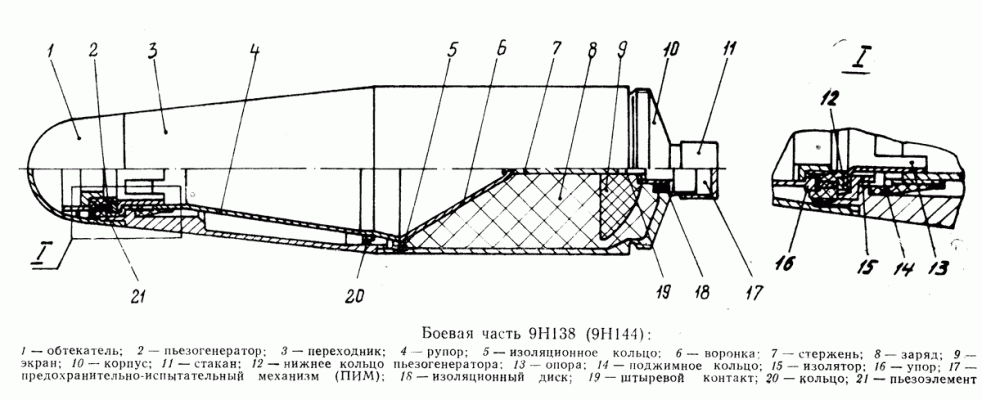1 fairing; 2 piezo generator; 3 adapter; 4 horn; 5 insulating ring; 6 funnel; 7 rod; 8 charge; 9 screen; 10 housing; 11 glass; 12 bottom ring; 13 support; 14 pressure ring; 15 insulator; 16 stop; 17 PIM; 18 insulating disc; 19 pin contact; 20 ring; 21 piezo element
Battle units (BC) 9H138 and 9H144 of cumulative effect, are similar in design and purpose. The 9H144 BC differs from the 9H138 BC in that it has a cumulative funnel material, an explosive substance and, therefore, increased efficiency. The BC is designed to engage armoured and small-size targets (such as DOT, DZOT, etc.).
The combat units consist of a hull 10 with a pressed charge 8 of the explosive substance, a cumulative funnel b and a screen 9, an explosive device 9E265, fasteners, insulation and current transmission elements. The explosive device consists of a piezo generator 2 and a safety executive mechanism (PIM) 17, the electrical connection between which is carried out through external and internal electrical circuits. The external electrical circuit consists of stop 16, fairing 1, adapter 3, case 10, glass 11 and case 17 of the PIM. Internal - from the bottom ring 12 piezo generator, support 13, horn 4, funnel 6, rod 7 and pin 19 PIM. Insulation of the electric circuits of the combat unit is provided by insulator 15, pressure ring 14, ring 20, insulating ring 5 and insulating disc 18. The tightness of the combat unit shall be ensured by sealing the threaded joints.
Principle of operation of a combat unit
When encountering an obstacle, a deformation of the fairing occurs 1. The compression force is transmitted through the 16 piezoelectric stop to the piezo elements 21. When the piezo elements are compressed, an electrical impulse is generated in the piezo generator and transmitted to the PIM via the external and internal electrical circuits.
The electrical impulse in the piezo generator is used to trigger a spark electrodetonator, a transfer charge and a PIM detonator, followed by a charge of 8 warheads. The products of the charge explosion crimp the funnel and a cumulative jet directed towards the obstacle is formed on the axis of the charge.
